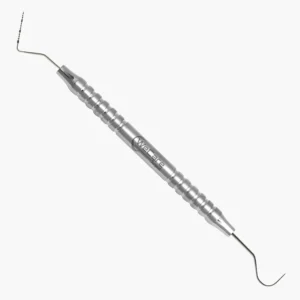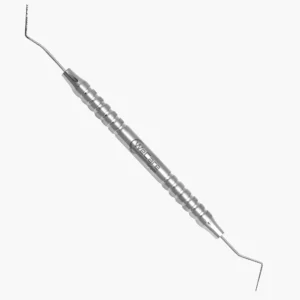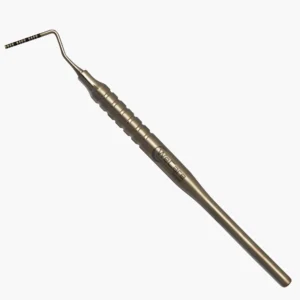Dental Periodontal Probe
wecare surgical2025-11-05T07:21:46+00:00Periodontal Probe
Precision Tool for Root Involvement Detection


A periodontal probe is a key diagnostic instrument dental professionals use to evaluate gum health and measure periodontal pocket depths.
At WeCare Surgical, we manufacture high-quality, CE-certified periodontal probes crafted from AISI 420 surgical-grade stainless steel. These probes are designed for accuracy, tactile sensitivity, and lasting durability in every procedure.
Available for bulk and single purchase
Trusted by clinicians and hygienists globally
Worldwide shipping
What Is a Periodontal Probe?
A periodontal probe is a slender, calibrated instrument used to measure the depth of gum pockets and detect signs of periodontal disease, gingival recession, or bone loss.
It helps dentists assess periodontal health, plan treatment, and monitor recovery over time.
In short:
- Probes measure periodontal pocket depth.
- Explorers detect tooth surface irregularities and caries.
Types of Periodontal Probes
Each probe is designed to perform a specific clinical function. Our range includes the most popular and internationally standardized types.
Williams Periodontal Probe
- Markings: 1, 2, 3, 5, 7, 8, 9, 10 mm
- Purpose: General periodontal measurement
- Features: Clear calibration, ergonomic handle
UNC Periodontal Probe
- Markings: 1–15 mm
- Purpose: Deep pocket and research-based evaluation
- Features: Consistent markings for detailed readings
Also called University of North Carolina Probe
UNC Periodontal Probe
- Markings: 1–15 mm
- Purpose: Deep pocket and research-based evaluation
- Features: Consistent markings for detailed readings
Also called University of North Carolina Probe
WHO Periodontal Probe
- Markings: 3.5, 5.5, 8.5, 11.5 mm with a 0.5 mm ball tip
- Purpose: Standardized periodontal screening (CPI Index)
- Features: Ball tip for reduced tissue trauma
Also known as CPITN Probe
Main Differences Between William Probe, UNC Probe, and WHO Probe
| Feature | Williams Probe | UNC Probe (UNC-15) | WHO Probe |
|---|---|---|---|
| Type | Manual Periodontal Probe | Manual Periodontal Probe | Manual Periodontal Probe |
| Markings | 1, 2, 3, 5, 7, 8, 9, 10 mm (no markings at 4 & 6 mm) | 1–15 mm (each mm marked) | 3.5–5.5 mm black band; 8.5, 11.5 mm |
| Tip | Straight, fine tip | Straight, fine tip | Ball tip (0.5 mm diameter) |
| Use | Routine measurement of pocket depth | Detailed measurement for research and clinical precision | Screening for CPI/BPE index (community surveys) |
| Accuracy | Standard | Very high (because each mm marked) | Moderate (for screening, not precise measurement) |
| Common Users | General dentists | Periodontists, researchers | Public health, general screening |
| Appearance | Simple markings, no color band | Fully graduated, no color band | Ball tip with black band |
Technical Specifications
| Feature | Details |
|---|---|
| Markings | Laser-engraved or color-coded |
| Handle Type | Knurled, ergonomic, non-slip |
| Sterilization | Fully autoclavable |
| Certification | CE & ISO Approved |
| Packaging | Single unit or custom bulk sets |
| Material | AISI 420 Surgical-Grade Stainless Steel |
How to Use a Periodontal Probe
- Insert the probe gently into the gingival sulcus.
- Align parallel to the tooth’s long axis.
- Read millimeter markings to determine pocket depth.
- Record six measurements per tooth (mesiobuccal, midbuccal, distobuccal, mesiolingual, midlingual, distolingual).
- Interpretation Guide:
- 1–3 mm → Healthy sulcus
- 4–5 mm → Early periodontal involvement
- 6+ mm → Advanced periodontitis
- Positioning
- Patient seated upright, clinician at 9–12 o’clock position.
- Use finger rest on chin or adjacent teeth.
- Angulation
- Insert probe parallel to long axis of the tooth.
- For molars, walk probe into col area.
- Insertion & Pressure
- Apply light force (~20 grams) — equivalent to the pressure of pressing a pen’s clicker.
- Probe should slide gently to the base of the pocket (not forced).
- “Walking” the Probe
- Move in 1–2 mm steps around the tooth (6 sites per tooth: mesio-buccal, mid-buccal, disto-buccal, etc.).
- Record deepest reading per site.
- Record Findings
- Pocket depth, bleeding on probing (BOP), suppuration, recession, mobility.
Pro Tip: Use a mirror and light to visualize the probe tip exiting the gingival margin — confirms accurate depth.
How to Use a Periodontal Probe
Trending Products
-
Dental Probes, Periodontal Probe, Williams Periodontal Probe
Dental Periodontal Probe Williams Explorer 23 Double Ended Diagnostic Instrument
0 out of 512.50 $Original price was: 12.50 $.9.25 $Current price is: 9.25 $. -
Dental Probes, Periodontal Probe, WHO Probe
Double-Ended #23 Explorer + 3-6-9-12 WHO Probe (AISI 420 Stainless Steel)
0 out of 512.50 $Original price was: 12.50 $.9.25 $Current price is: 9.25 $. -
Dental Probes, Periodontal Probe, Williams Periodontal Probe
Double-Ended Goldman Fox Williams Probe / #23 Explorer (AISI 420 Stainless Steel)
0 out of 512.50 $Original price was: 12.50 $.9.25 $Current price is: 9.25 $. -
Dental Probes, Periodontal Probe, UNC Periodontal Probe
UNC-15 Periodontal Probe – Single Ended | AISI 420 Stainless Steel
0 out of 512.50 $Original price was: 12.50 $.8.75 $Current price is: 8.75 $.
Clinical Interpretation_ Perio Probe
| Measurement | Meaning |
|---|---|
| 1–3 mm | Healthy sulcus |
| 4–5 mm | Early periodontitis (monitor) |
| ≥6 mm | Moderate–severe; needs scaling/root planing or surgery |
| BOP present | Active inflammation |
| Furcation Grade I–III | Bone loss between roots (Nabers probe) |
Periodontal Probe vs. Explorer Probe
| Feature | Periodontal Probe | Explorer Probe |
|---|---|---|
| Function | Measures gum pocket depth | Detects caries or surface irregularities |
| Tip | Blunt/Rounded | Sharp, flexible |
| Markings | Yes (calibrated) | No |
| Purpose | Measuring Instrument | Detection Instrument |
Explorers such as Briault or Shepherd’s Hook are sometimes mislabeled as “probes,” but their true function is detection, not measurement.
Periodontal Probe Markings
Common calibration patterns include:
- Williams: 1, 2, 3, 5, 7, 8, 9, 10 mm
- UNC 15: 1–15 mm continuous
- WHO: 3.5–5.5–8.5–11.5 mm with 0.5 mm ball tip
Markings help clinicians achieve consistent measurement accuracy.
Get Periodontal Probes at Factory Prices
Upgrade your diagnostic instruments with WeCare Surgical Periodontal Probes.
Perfect for dental clinics, hygienists, and distributors seeking premium quality at competitive prices.
- Crafted from AISI 420 stainless steel
- CE / ISO Certified
- Available for fast worldwide delivery
- Why Choose WeCare Surgical
- Long-lasting durability and corrosion resistance
- Designed for comfort and precision
- Laser-engraved for permanent visibility
- Safe and reusable after sterilization
- Factory-direct rates for clinics and distributors
- Order & Shipping Information
- Available for: Single & Bulk Orders
- Dispatch Time: Within 10 Days (Depends on Order)
- Global Delivery: Available worldwide via DHL / FedEx
- Packaging: Sterile, sealed pouches
- Payment: Secure online checkout (PayPal, Wire Transfer)
- Order & Shipping Information
- Available for: Single & Bulk Orders
- Dispatch Time: Within 10 Days (Depends on Order)
- Global Delivery: Available worldwide via DHL / FedEx
- Packaging: Sterile, sealed pouches
- Payment: Secure online checkout (PayPal, Wire Transfer)
Frequently Asked Questions
Williams has specific marking gaps (no 4 or 6 mm), while UNC provides continuous markings from 1–15 mm.
Yes, they are fully autoclavable and designed for repeated use.
It usually doesn’t. Slight discomfort may occur if inflammation is present.
The Williams probe is ideal for general use and training due to its simplicity and accuracy.






